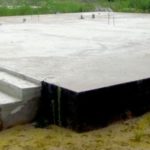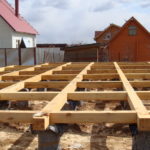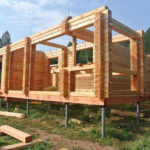The foundation of any wooden house collapses over time and requires repair. Cracks on the walls, as well as distortions of door and window openings, will prompt the homeowner about the need to restore its integrity. Repair of the foundation of a wooden house will be required if deformation or destruction of the supporting surfaces and protruding parts of its base is found.
Reasons for damage to the foundation

When starting to repair the old foundation of a wooden house, you first need to understand the reasons that caused its damage. The most common are the following:
- concrete has lost its original strength;
- the soil under the building has changed its bearing capacity;
- mistakes made during the laying of the foundation;
- use of low-quality building materials, etc.
By their nature, unpredictable changes occurring in the structure of the soil (geological and hydrological), due to which there is a displacement and subsidence of the foundation. The strength of concrete is also affected by the constant presence of water in the soil, which saturates the foundation with moisture, which destroys the material during freezing. The reasons for the appearance of excess moisture in the soil may be improper arrangement of the blind area and drainage (or their absence) or an increase in the level of groundwater. Affect the strength of concrete and corrosion processes, which over time contribute to the destruction of the foundation.
However, experts believe that the main reason for the destruction of the foundation is non-compliance with the technology of its laying. For example, if measurements have not been taken to determine the type of soil and its density, this may later cause cracks in the foundation due to its uneven shrinkage. Many private developers are guilty of this, trying to reduce the financial costs of building a house. In addition, a team of unskilled workers hired to build a foundation can:
- dig a trench of insufficient depth;
- improperly reinforce the concrete base;
- add too much salt to the sand-cement mixture, hoping that the foundation will harden faster, etc.
The developer himself can, in order to save money, bring cement of a cheaper brand to the construction site.
An old building may sink due to the construction of other structures next to it, for example, a covered veranda rigidly connected to the house. In this case, the total weight of the structure will increase, exerting uneven pressure on the ground.
Varieties of foundations for a wooden house
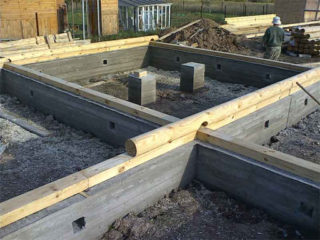
For the construction of wooden houses, as a rule, the following types of foundations are used:
- tape;
- columnar;
- pile;
- slab.
The columnar foundation is used in the construction of small houses or outbuildings. The basement part of the building is located on vertical supports, and the structural elements responsible for the uniform distribution of loads are made on beams.
The most expensive of these types of bases is slab. It is equipped in areas with moving soil prone to subsidence.Structurally, such a foundation looks like a one-piece monolithic base, previously cast into the formwork.
The basement of the tape type is a monolithic structure of the same section along the entire perimeter of the structure being erected. High reliability and increased level of protection allows it to be used in the construction of buildings of various types.
For the construction of the pile foundation, special vertical elements of different lengths are used. They are made from concrete or high-strength steel. Foundations on such piles are used in the construction of wooden houses in mountainous areas.
Types and degrees of destruction
Classification of deformations
All damages of the foundation base of a wooden house that are encountered in practice are divided into groups:
- Minimal damage - these include defects that do not affect the bearing capacity of the structure. Such damage is clearly visible and easy to repair.
- Damage of moderate severity - subsidence of the foundation and the appearance of cracks on its surface. In this case, horizontal cracks are the least hazardous. The appearance of vertical and zigzag patterns should at least alert the homeowner.
- Catastrophic destruction - damage that appears that can lead to the destruction of the entire house. They appear if minimal deformations and moderate damage were not eliminated in time. The overhaul method depends on the type of foundation.
- Fatal destruction - damage to the base, in which its repair is impossible or economically inexpedient.
The total amount of detected damage determines the type of repair of the foundation masonry, which can be partial or major. The latter is done with significant destruction or complete destruction of the base.
Determination of the nature and degree of destruction
The nature of the damage and the degree of possible damage can be determined using the so-called beacons, made, for example, of paper. A properly installed beacon will show the homeowner the rate at which the base of the house is breaking down. Glue the beacon across the crack, after cleaning the surface around it. Beacon thickness - no more than 5 mm. If after some time the beacons break, this indicates the need for urgent repairs. By the nature of the gap, you can also determine the direction of subsidence of the foundation.
If the beacon remains intact for a long time, this indicates that the ground under the building has slightly moved and has already taken its place. In this case, it is necessary to seal the existing cracks with cement mortar.
Repair of the foundations of a wooden house
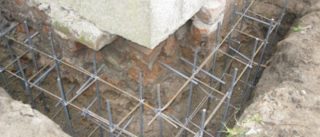
Repair work should be preceded by soil studies to determine the type, stability and strength of the soil. The depth of deepening of the updated structure of the foundation masonry will depend on this.
Repair of the strip foundation
If the subsidence of a wooden house occurs evenly, the reconstruction of the tape-type foundation will not cause great difficulties. You can repair it according to the following scheme:
- They dig a trench about 0.5 m wide around the perimeter of the house. At the same time, its depth should be sufficient to assess the condition of the foundation.
- The crumbling pieces of the old foundation masonry are removed.
- Sections of reinforcement are driven into the holes drilled in the base and connected by welding into one structure.
- The trench is poured with concrete. The concrete mixture is poured gradually, in sections of no more than 150 cm. Each section is connected to the existing base and reinforcement to each other. After the flooded area has grabbed, the work continues.It is necessary to achieve maximum saturation of the old foundation base with concrete mortar.
- The existing trench is covered with a 20 cm thick layer of construction sand.
- Wooden formwork is assembled along the height of the basement.
- The concrete mixture is poured, laying a continuous reinforcing mesh between its layers.
After completing the work, do not forget to mount the blind area and drainage systems.
Pile / column foundation repair
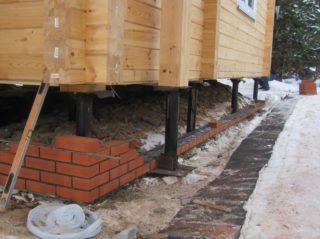
Repair of a pile / columnar base is, as a rule, reduced to straightening rickety supports:
- digging from the side opposite to the skew;
- gently straighten the support;
- the place vacated in the ground is poured with a mixture of gravel, cement and water (ratio 2: 1: 2).
If the supporting elements are damaged, a reinforcing concrete belt is erected.
When the pedestals need to be replaced, the entire house will need to be raised. Moreover, if the old brick supports have undergone severe destruction, it is better to reconstruct the foundation with screw piles.
It is better to entrust the reconstruction of the pile foundation to specialists who have experience in carrying out such work and a special tool for this.

